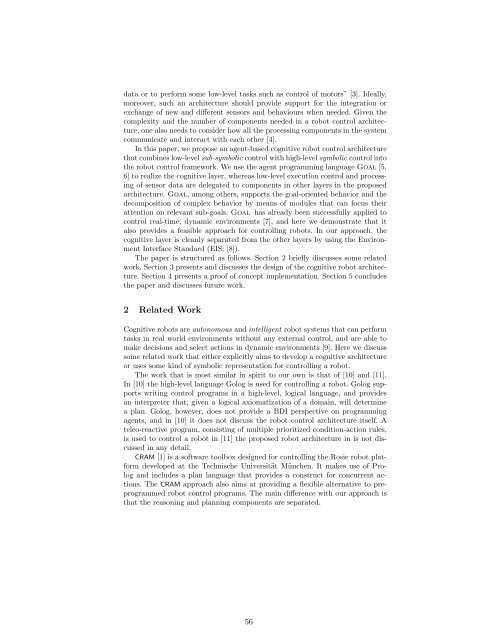Here - Agents Lab - University of Nottingham
Here - Agents Lab - University of Nottingham
Here - Agents Lab - University of Nottingham
You also want an ePaper? Increase the reach of your titles
YUMPU automatically turns print PDFs into web optimized ePapers that Google loves.
data or to perform some low-level tasks such as control <strong>of</strong> motors” [3]. Ideally,moreover, such an architecture should provide support for the integration orexchange <strong>of</strong> new and different sensors and behaviours when needed. Given thecomplexity and the number <strong>of</strong> components needed in a robot control architecture,one also needs to consider how all the processing components in the systemcommunicate and interact with each other [4].In this paper, we propose an agent-based cognitive robot control architecturethat combines low-level sub-symbolic control with high-level symbolic control intothe robot control framework. We use the agent programming language Goal [5,6] to realize the cognitive layer, whereas low-level execution control and processing<strong>of</strong> sensor data are delegated to components in other layers in the proposedarchitecture. Goal, among others, supports the goal-oriented behavior and thedecomposition <strong>of</strong> complex behavior by means <strong>of</strong> modules that can focus theirattention on relevant sub-goals. Goal has already been successfully applied tocontrol real-time, dynamic environments [7], and here we demonstrate that italso provides a feasible approach for controlling robots. In our approach, thecognitive layer is cleanly separated from the other layers by using the EnvironmentInterface Standard (EIS; [8]).The paper is structured as follows. Section 2 briefly discusses some relatedwork. Section 3 presents and discusses the design <strong>of</strong> the cognitive robot architecture.Section 4 presents a pro<strong>of</strong> <strong>of</strong> concept implementation. Section 5 concludesthe paper and discusses future work.2 Related WorkCognitive robots are autonomous and intelligent robot systems that can performtasks in real world environments without any external control, and are able tomake decisions and select actions in dynamic environments [9]. <strong>Here</strong> we discusssome related work that either explicitly aims to develop a cognitive architectureor uses some kind <strong>of</strong> symbolic representation for controlling a robot.The work that is most similar in spirit to our own is that <strong>of</strong> [10] and [11].In [10] the high-level language Golog is used for controlling a robot. Golog supportswriting control programs in a high-level, logical language, and providesan interpreter that, given a logical axiomatization <strong>of</strong> a domain, will determinea plan. Golog, however, does not provide a BDI perspective on programmingagents, and in [10] it does not discuss the robot control architecture itself. Ateleo-reactive program, consisting <strong>of</strong> multiple prioritized condition-action rules,is used to control a robot in [11] the proposed robot architecture in is not discussedin any detail.CRAM [1] is a s<strong>of</strong>tware toolbox designed for controlling the Rosie robot platformdeveloped at the Technische Universität München. It makes use <strong>of</strong> Prologand includes a plan language that provides a construct for concurrent actions.The CRAM approach also aims at providing a flexible alternative to preprogrammedrobot control programs. The main difference with our approach isthat the reasoning and planning components are separated.56


